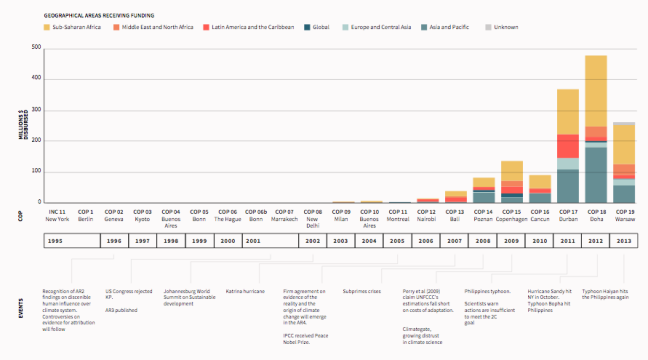A closer look at the practices of vulnerability assessment and the priorities of adaptation funding.

Introduction
The burning issue in the climate change adaptation debate is arguably about funding: who should receive it, and why? The amount of money that a donor is willing to pledge for adaptation aid; from which countries and which purposes; and the justification given in defence of these choices, are matters of concern in a broad range of adaptation related discussions.
This is especially pertinent at the international level where the negotiations on climate change have moved from mitigation to also include adaptation, an issue which could in principle be seen as a national responsibility. At this level it becomes particularly acute to justify which countries should receive aid and why. A much debated method for doing so is the assessment of vulnerability to climate change. Vulnerability often implies a broad socio-economic conception about what it means to be capable of adapting. A conception that can make it hard to distinguish adaptation action from development in general.
If you want to learn more about the project, please read this article.
The rise of adaptation in the climate change debate
At the international level of negotiations, adaptation became one of the four pillars of the Bali Action Plan in the 2007 Conference of the Parties (COP). In a similar manner the fourth and fifth IPCC reports (2007, 2013-2014) display an increased attention to adaptation. In sum, adaptation is now being integrated at all levels of climate politics – not just in international negotiations and expertise but also at the individual country level, from national to sub-national to municipal jurisdictions, in both developing and developed countries (see figure 1).
It is still not clear exactly what adaptation means and how it can be achieved. Against very narrow framings of the concept some actors have emphasized the importance of placing adaptation to climate change within a broader social, economic and environmental conception of vulnerability. Others consider adaptation as a natural extension of Disaster Risk Reduction (DRR), which places it within a long established community of practice (Mercer, 2010). Others still, see adaptation as a path toward the making of a more resilient society, which involves less emphasis on the structural causes of vulnerability, and more attention to investment practices that produce and enhance resilience, and ultimately to good governance (Adger and Brown, 2009; Adger et al., 2003). Moreover, the concept of adaptation tend to be framed differently in different development contexts (Huq and Reid, 2004).

Figure 1: The rise of adaptation funding (Climaps.eu). The histogram shows the growing volume of international adaptation funding starting from 2003, distributed across geographical regions. Click to see main Issue map.
The controversy on how to assess vulnerability
A serious challenge following from the rise of adaptation and its inherent complexity is the question of how to develop robust and credible indicators and criteria for measuring vulnerability (Birkmann 2006; Eriksen and Kelly 2006; Adger 2006). Since the 1990s there have been quite a few projects that attempted to develop indices that claim to measure vulnerability to social and/or environmental change (Barnett, Lambert and Fry 2008). Such indices typically combine multiple indicators of a variable into a single measure, thus ordering a set of entities with respect to quantitative attributes or traits.
One pragmatic way of exploring these difficulties is to triangulate some of the most commonly used vulnerability indices to see how they agree or disagree in their assessment of different countries. For a first exploration we selected Germanwatch’s Climate Risk Index (CRI), DARA’s Climate Vulnerability Monitor (CVM) and the Global Adaptation Initiative’s Global Adaptation Index (GAIN), as can be seen in the figure below.

Figure 2: Who is vulnerable according to who? How do vulnerability indices agree or disagree in their assessment of different countries (from Climaps.eu). Notice the countries that have been deemed simultaneously most vulnerable and least vulnerable by different indices. Click to see main Issue map.
Figure 2 show that very few countries (7 in total) are among the most vulnerable according to all three indices. Even more interesting is the fact that quite a few countries (25) are simultaneously assessed to be most vulnerable and least vulnerable according to different indices. Considering these difficulties, it is perhaps not surprising that the assessment of climate change vulnerability by means of indicators continues to divide both policy and academic communities alike (Hinkel 2011, pp. 198).
Further reading
The article further explores the relation between climate change adaptation in general, vulnerability in particular, and development imperatives. Their mapping show that priorities of different adaptation funds align with different ways of assessing vulnerability to climate change. Adaptive capacity is one of the areas where the overlap between adaptation and development imperatives are strongest. More developed countries tend to have higher adaptive capacity, and so it can be argued that being less developed is in itself an indicator of vulnerabillity to climate change.
The article also includes both global, domestic and regional perspectives on adaptation funding and the case of Germany was examined to see how domestic adaptation funding is prioritised and how it compares with the vulnerability of natural areas within the country. Lastly, the article explore how the climate specific indices fare in the news media.
(0) Comments
There is no content